Abstract
Dairy foods are essential in the diet, although in some susceptible individuals they may cause allergy to cow’s milk proteins. Therefore, alternative methods are sought to reduce their allergenicity. Transglutaminase (TG) is widely used in dairy products mainly to improve texture. Although it has been claimed that TG can be used to modify the digestibility and allergenicity of foods, its impact within a real matrix has been rarely studied. The aim of this work was to assess the allergenic potential of crosslinked skim milk (SM), milk casein fraction (CN), and whey protein (WP). To this purpose, inhibition ELISA with sera from milk allergic patients, in vitro activation tests of mouse mast cells and splenocytes, and simulated gastrointestinal digestion assays were performed. The results showed that cross-linking increased the binding of IgE to WP, but decreased IgE-binding to SM and CN. However, no differences were observed in the ability of cross-linked proteins to induce mast cell degranulation compared to native proteins. The cross-linking of SM and CN reduced Th2 cytokine release from the splenocytes of sensitized mice. All TG-treated samples exhibited more resistance to in vitro digestion than the untreated proteins and the human IgE binding capacity after digestion was higher. In conclusion, TG treatment of milk proteins does not reduce the risk of eliciting allergic symptoms in cow’s milk allergic patients.
1. Introduction
Food allergies are increasing around the world with unprecedented complexity and severity. They constitute a serious health problem that causes large public health costs and severely deteriorates the quality of life of patients. Of all known food allergies, cow’s milk allergy is of special interest due to its high incidence during the first three years of life [1]. Mainstay milk allergy treatment consists of avoiding all foods containing milk proteins, nutritional counseling, as many foods cannot be consumed, and emergency treatment to reduce the allergic response. However, avoidance of milk proteins involves quite a few dietary restrictions since they are used as ingredients in many products beyond dairy foods. Furthermore, the positive contribution of milk proteins and related bioactive peptides to a healthy diet has been increasingly documented [2] and the lack of some micronutrients present in dairy foods, such as calcium, can also have other (deleterious) effects on the growth and development of children [3].
Different approaches have been used to try to produce hypoallergenic foods, taking advantage of the transformations that food components undergo during processing [4]. Among them, attention has recently been paid to protein cross-linking with transglutaminase, an enzyme that catalyzes the formation of isopeptide bonds between the amino acids glutamine and lysine in proteins, in part because it has been accepted in the European Union for the marketing of food products. Its most widespread use includes the manufacture of cheese and other dairy products, meat processing, production of edible films, and manufacture of bakery products. Studies on the crosslinking of food proteins with TG mainly evaluate its influence on physical properties of food, such as solubility, gelling, or emulsifying capacity, among others. Its contribution to the reduction of allergenicity has also been assessed [5]. However, beyond some promising results, the optimal conditions for its use have not yet been defined, nor is there consensus on its application by the food industry.
Partial hydrolysis of whey proteins or casein followed by TG-catalyzed crosslinking of the hydrolysates was proposed as a strategy to produce protein polymers with lower antibody binding properties but with improved textural and sensory properties [6,7]. Regarding the intact proteins, TG-induced polymerization was shown to decrease the antigenicity of whey protein and casein preparations [7] and TG-polymerized β-Lg gave negative prick tests in allegic subjects [8]. However, the assessment of the sensitizing and eliciting capacity of polymerized milk proteins in vivo revealed that TG-treated caseinate exhibited a somehow lower sensitizing potential but similar eliciting potential relative to its non-modified counterpart, while cross-linked β-Lg elicited a stronger allergic sensitization and a lower allergic effector response [9,10]. This different behavior was attributed to the enhanced resistance to proteolysis of cross-linked β-Lg, which redirected protein transport to PP and changed uptake and processing by antigen presenting cells [10]. Therefore, the relevance of protein cross-linking in the case of food allergy needs to be studied by taking into account the real food matrix that contains components with different resistance to processing and gastroduodenal digestion, factors which ultimately allow them to interact with the intestinal mucosa where absorption occurs [4].
The aim of this work was to assess the effect of TG-mediated crosslinking on the IgE-binding, ability to induce mast cell degranulation, and immunostimulating properties of milk in comparison with its two main protein fractions. Moreover, a physiologically relevant in vitro digestion model was used to investigate the susceptibility to digestion of the cross-linked milk proteins and the binding of human IgE to the resulting digests.
2. Materials and Methods
2.1. Crosslinking of Milk Proteins
Milk, obtained from the local farm La Colmenareña (Madrid, Spain), was skimmed by centrifugation, 3000× g at 4 °C for 30 min, filtered through glass wool, lyophilized, and stored at −20 °C. Commercial micellar casein Prodiet 85B (CN) was from Ingredia S.A, (Arras, France). Whey protein isolate (WP) (LACPRODAN DI-9224K) was from Arla Foods Ingredients (Sønderhøj, Denmark). Protein concentration of skim milk (SM), CN, and WP was determined by the Kjeldahl method [11]. The absence of lipopolysaccharide (LPS) was confirmed using the transfected cell line THP1-XBlue™ and the QUANTI-Blue™ assay (Invitrogen, Carlsbad, CA, USA), following the manufacturer’s instructions. Protein crosslinking was performed with TG (MTG-Activa ®-MP, Ajinomoto Co., Sao Paulo, Brazil; enzymatic activity:100 U/g), a commercial powder including 1% TG and 99% maltodextrin. The enzyme was dissolved in PBS and mixed (1:1, v/v) with the SM, CN, and WP solutions to achieve a final protein concentration of 2.5 mg/mL and a final enzyme activity of 1, 10, 100 and 1000 U in the reaction mixture. TG cross-linking experiments were carried out at 40 °C for 1, 3, 8, and 24 h. Then, samples were heated at 90 °C for 10 min for enzyme inactivation.
2.2. Electrophoresis SDS-PAGE
Electrophoresis was performed in a CriterionTM cuvette on preform bis–tris gels (12%) at 120 V, using XT-MES as running buffer. Samples were diluted in sample buffer with 5% (v/v) β-mercaptoethanol to a final protein concentration of 250 µg/mL, then heated at 95 °C for 10 min. Hence, 30 μL of sample were placed into each lane. Staining was completed with Bio-Safe Coomassie G-250. All equipment and reagents were from Bio-Rad (Richmond, CA, USA).
2.3. Human IgE Binding by Inhibition ELISA
Human IgE-binding to native and TG cross-linked SM, CN, and WP and their digests was evaluated by inhibition ELISA [12], using a pool of 7 different sera from milk allergic patients with levels of IgE specific to α-LA, β-LG, and CN described in Table 1. To perform ELISA, the final protein concentration was 2.5 mg/mL and the final enzyme activity in the mixture was 100U, maintaining the reaction for 24 h.

Table 1.
Sera used in the study. Specific IgE levels (kU/L) towards casein (CN), α-lactalbumin (α-LA), β-lactoglobulin (β-LG) and cow’s milk of the human sera used in the inhibition ELISA and mast cell activation assay.
2.4. Bone Marrow Derived Mast Cells
Bone marrow-derived mast cells (BM-MCs) were in vitro differentiated into a mucosal-like phenotype as described previously [13]. Briefly, bone marrow cells were collected from femurs and cultured in DMEM with glucose and L-glutamine, supplemented with 10% fetal bovine serum, penicillin/streptomycin, and sodium pyruvate (Biowest, Nuaillé, France), plus stem cell factor, IL-3, IL-9 and TGF-β (Peprotech, Rocky Hill, NJ, USA), for a minimum of 4 weeks and a maximum of 8 weeks before being used. For activation through cross-linking of the IgE receptor, MCs (1 × 106 cells) were sensitized with serum from BALB/c mice orally sensitized with 5 mg of SM, CN, and WP plus 10 μg of cholera toxin (List Biologicals, Campbell, CA, USA) [14]. After washing, MCs were activated with samples in HEPES degranulation buffer. To study the activation through an IgE independent pathway, non-sensitized MCs were also stimulated with samples. β-hexosaminidase was detected by an enzymatic colorimetric assay [15]. The percentage of β-hexosaminidase release was calculated considering the total β-hexosaminidase content.
2.5. Cell Viability of Mice Splenocytes
The cell viability assay was carried under the culture conditions described below and determined by 3-(4,5-dimethylthiazol-2-yl)-2,5-diphenyltetrazolium bromide (MTT) method. Hence, 20 μL of MTT solution (5 mg/mL PBS) were added to each well. Samples were incubated for a further 4 h in dark. Then, media were removed, and 100 μL of dimethyl sulfoxide:methanol (1:1) was added to dissolve the purple insoluble MTT formazan, and the absorbance was measured at 570 nm in a Fluorostar Optima microplate-reader (BMG LabTech, Ortenberg, Alemania) using a 650 nm filter as a reference.
2.6. Cytokine Secretion of Mice Splenocytes
Splenocytes were obtained from female BALB/c mice orally sensitized with SM, CN, and WP (n = 5). After sacrifice, whole spleens were excised, and cell suspensions were prepared. Splenocytes were cultured in RPMI 1640 plus 10% of fetal bovine serum, L-glutamine (2 mM), penicillin (50 U/mL) and streptomycin (50 μg/mL) (all from Biowest) at 4 × 106 cells/mL in 48-well plates. Stimuli consisted of 200 μg/mL of untreated or TG cross-linked SM, CN, WP, and PBS as negative control. Control and stimulated splenocyte cultures were maintained for 72 h at 37 °C in a 5% CO2 gassing incubator and were performed in duplicate. The supernatants were collected and kept frozen (−80 °C) until assayed for IL-4 and IL-13 quantification using mouse ELISA kits (eBioscience, San Diego, CA, USA).
2.7. In Vitro Gastrointestinal Digestion
Simulated gastrointestinal digestion of native and TG cross-linked SM, CN, and WP was performed as described previously [16]. Briefly, a gastric phase was conducted with porcine pepsin (EC 3.4.23.1, 4220 U/mg, Sigma Aldrich, St. Louis, MO, USA), at a final concentration of 182 U/mg of protein for 1 h at 37 °C adjusted to pH 2.0 (2 M HCl). The reaction was stopped by raising the pH to 7.0 (2 M NaHCO3). The duodenal phase was carried out using gastric digests by adding Corolase PP (AB Enzymes, Darmstadt, Germany) at an enzyme:substrate ratio of 1:25 (w/w), and incubating for 30 min at 37 °C. Stopping of the reaction was achieved by heating at 95 °C for 10 min.
2.8. RP-HPLC
RP-HPLC analysis was conducted on a Waters 600 HPLC instrument (Waters, Mildford, MA, USA) with a RP318 column (250 × 4.6 mm, 5 µm of particle size, 300Å pore size, Bio-Rad). 100 µL (2 mg/mL) of sample were injected and eluted for 60 min using 0.37% (v/v) trifluoroacetic acid from Scharlau Chemie (Barcelona, Spain) in double-distilled water as phase A, and 0.27% (v/v) trifluoroacetic acid in HPLC-grade acetonitrile (Lab-Scan, Gliwice, Poland) as phase B. The gradient was linear, increasing B in A from 0% to 60% at a flow rate of 1 mL/min during 90 min, followed by a 35-min wash with 60% and 10 min with 100% of solvent B. Detection was at 214 nm and data were processed by using Empower 2 Software from Waters.
2.9. Statistical Analysis
Statistical analyses were performed using GraphPad Prism software, version 7.0e (GraphPad). The two-tailed Student’s t test was used for determining statistical significance (p < 0.05). Data are expressed as the mean ± SEM of 3 independent experiments.
3. Results and Discussion
3.1. Protein Polymerization
CN, WP, and SM were susceptible to TG mediated cross-linking (Figure 1). As expected, increasing TG doses and incubation times led to higher polymerization degrees. The casein fraction was the most susceptible to polymer formation due to its little secondary and tertiary structure, flexible and random-coil arrangement, and absence of any disulphide bonds in αS1- and β-CNs, which allow a greater exposure of reactive groups and an increased accessibility to the enzyme [17]. The presence of protein aggregates corresponding to dimers and trimers was observed after 1 h of CN polymerization with 1 and 10 U of TG/g. After longer incubation periods, higher polymers were detected, and no presence of monomers was observed at 24 h (Figure 1a). The polymerization of β- and κ-CNs occurs earlier than that of the other milk proteins, as also observed by other authors [18]. Monomers of β-LG and α-LA were still detected after 24 h of treatment with TG, even at the highest concentration used (1000 U/g of protein) (Figure 1b). WP, due to their compact globular structures, cross-linked less efficiently [17]. Although there is no specific legislation about minimum or maximum quantities of TG allowed to be added to food products in the European Union or in the United States, most studies that addressed the use of TG in dairy foods use a maximum of 100 U/g of protein [19,20]. We evaluated the use of 1000 U/g of protein to assess whether higher enzyme activity could result in higher crosslinking efficiency, but although polymerization increased slightly compared to 100 U/g, it was not enough to convert all monomeric proteins into polymers. The dairy matrix did not change the susceptibility to cross-linking of the main milk fractions, as similar effects were observed in milk and in the isolated proteins (Figure 1c).
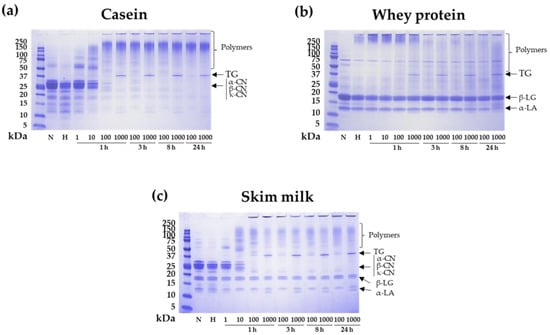
Figure 1.
Electrophoretic patterns of TG treated samples. SDS-PAGE using Bis-Tris 12% acrylamide gels of (a) casein, (b) whey proteins and (c) skim milk after cross-linking using transglutaminase (TG) at 1, 10, 100, and 100 U of TG/g of protein during 1, 3, 8, and 24 h of incubation at 40 °C. Heating to 90 °C for 10 min to deactivate the TG was applied to the samples. Native (N) and heated (H, 90 °C for 10 min) proteins were included as control samples. α-casein = α-CN, β-casein = β-CN, k-casein = k-CN, β-lactoglobulin = β-LG and α-lactalbumin = α-LA.
3.2. Influence of Crosslinking on IgE-Binding Capacity
IgE reactivity of pooled sera from milk allergic patients from our serum library (Table 1) towards intact and polymerized samples was assessed by inhibition ELISA. Cross-linking of CN and SM led to a reduction in their IgE binding capacity. However, after treatment with TG, IgE binding to WP increased (Figure 2a), probably due to the exposure of hidden epitopes due to conformational changes in the protein [21]. Other allergenic proteins or extracts, such as ovalbumin [22], Ara h 1 [23], tropomyosin [24], β-LG [20], and wheat flour [25], have shown a reduced allergenicity after cross-linking with TG. However, peanut [26] and wheat [27] proteins showed higher IgE binding capacity after cross-linking with TG. These results highlight the importance of the substrate type in the IgE binding capacity of the TG reaction products.
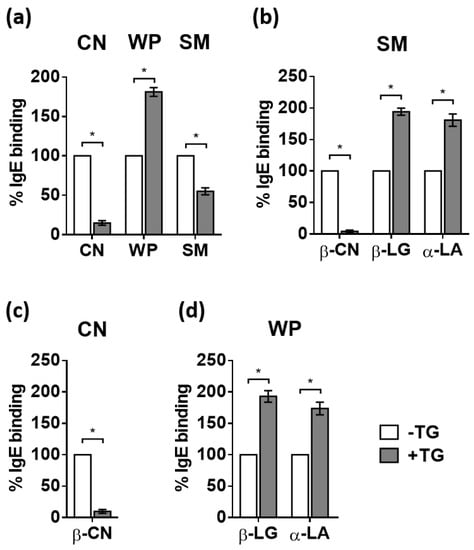
Figure 2.
IgE binding to casein (CN), whey proteins (WP) and skim milk (SM), either untreated (−TG, white bars) or treated with transglutaminase (+ TG, grey bars), estimated by inhibition ELISA with sera from milk allergic patients (Table 1). (a) IgE binding to CN, WP, and SM, (b) specific IgE binding to β-casein (β-CN), β-lactoglobulin (β-LG), and α-lactalbumin (α-LA) in SM; (c) specific IgE binding to β-CN in CN, and (d) specific IgE binding to β-LG and α-LA in WP. The proteins used for pre-coating the plates are indicated on the x-axes. Data are expressed as means ± SEM of 3 different experiments. Statistically significant differences (p < 0.05) are indicated by asterisks.
The contribution of individual milk proteins to the binding of IgE capacity to SM, CN, and WP was assessed by inhibition ELISA pre-coating the plates with either β-CN, β-Lg, or α-la. In SM, the binding of IgE to β-CN was greatly reduced after treatment with TG to 3% of the IgE binding to β-CN in the untreated sample (Figure 2b). However, the specific IgE binding to β-LG and α-LA increased to 194% and 181%, respectively. This is consistent with the data obtained when specific inhibition ELISA was performed on CN and WP samples (Figure 2c,d). Different results were found by Fotschki et al., who showed that polymerization with TG decreased β-LG immunoreactivity and increased IgE binding of α-CN [20]. However, they used polyclonal rabbit antibodies, obtained from rabbits immunized against commercial purified allergens instead of human sera from naturally sensitized allergic patients. Villas-Boas et al. [19] also showed that TG crosslinking decreased the potential antigenicity of β-LG by modifying or hiding epitopes, although cross-linking was performed in the presence of cysteine.
Because mast cells are the main effector cells of the allergic response, we assessed the ability of TG-treated SM, CN, and WP to activate them through an IgE dependent pathway using BM-MCs (Figure 3). Cells were primed with sera from mice sensitized to SM, CN or WP and then treated with specific antigens or PBS. No differences were observed in the percentage of β-hexosaminidase released by BM-MC after incubation with TG-treated SM, CN, and WP compared to cells stimulated with the untreated proteins. To rule out that cell activation occurred through a non-IgE-mediated pathway, we confirmed that neither the protein samples treated with TG nor TG alone induced degranulation in non-sensitized cells. These data would indicate that, although the IgE-binding capacity of milk proteins is affected by the action of TG, the effector cellular response may not be altered. A similar behavior was observed by Nakamura et al. [28], who observed a pronounced increase in the IgE reactivity of a hydrolyzed wheat protein treated with TG without affecting the IgE response of patients with wheat allergy.
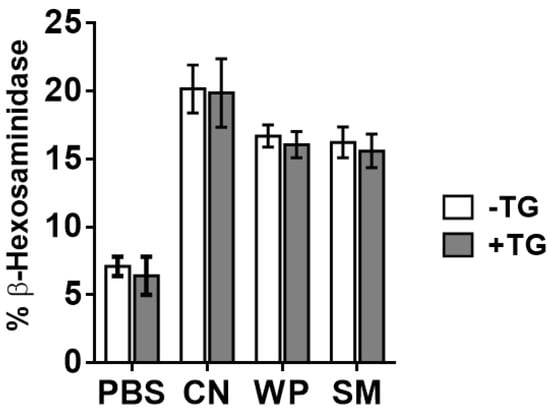
Figure 3.
Mast cell degranulation capacity. Measurement of β-hexosaminidase release induced by casein (CN), whey proteins (WP) and skim milk (SM), either untreated (white bars) or treated with TG (grey bars), after sensitization of bone marrow derived mast cells with sera from CN, WP and SM allergic mice, respectively. Data are expressed as mean ± SEM of 3 different experiments.
3.3. Immunostimulating Properties of Crosslinked Milk Proteins
The immunostimulating properties of TG-treated SM, CN, and WP were evaluated in splenocytes from SM, CN, and WP sensitized BALB/c mice, respectively (Figure 4). Stimulation of spleen cells with untreated CN, WP, and SM led to an increased Th2 cytokine production compared with control cells (PBS). Cytokine secretion from cells stimulated with TG and PBS was similar (not shown), indicating an antigen specific stimulation. Cross-linking of SM and CN reduced the release of IL-4 from the splenocytes to a level similar to that of control cells. IL-13 secretion was also reduced, although it was not significantly different with respect to the control cells. In contrast, IL-4 and IL-13 production in splenocytes stimulated with WP was similar regardless of whether WP was cross-linked or not. Th2 cytokines (IL-4, IL-5, and IL-13) secreted by differentiated and expanded T-helper lymphocytes favor the activation of B lymphocytes that differentiate into plasma cells, producing large amounts of IgE antibodies, whose activation on the surface of basophils and mast cells triggers the allergic response [29]. The lower levels of IL-4 and IL-13 detected in the supernatants of splenocytes incubated with TG-treated SM and CN, but not WP, may indicate that crosslinked SM and CN exert positive immunosuppressive effects.
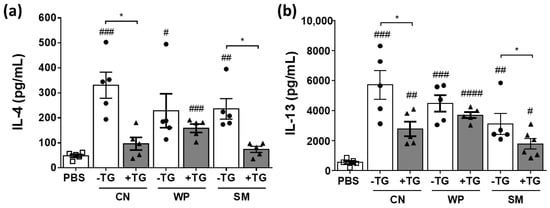
Figure 4.
Stimulation of splenocytes. Th2 cytokines (a) IL-4 and (b) IL-13 released from cultures of spleen cells from casein (CN), whey protein (WP), and skim milk (SM) sensitized BALB/c mice (n = 5) stimulated with CN, WP, and SM, either untreated (white bars) or treated with TG (grey bars). Pounds and asterisks indicate, respectively, statistically significant differences with respect to cells stimulated with PBS or between both experimental groups. Data are expressed as mean ± SEM. # and * p < 0.05, ## p < 0.01, ### p < 0.001, #### p < 0.0001.
Some studies have determined the influence of crosslinking on the allergenic properties of proteins through the analysis of the IgE binding capacity by ELISA, Western blotting, or degranulation tests using basophil and mast cell cultures [30,31,32], but very few have determined their impact on other immune cells. Bai et al. [33] observed that TG cross-linked tofu proteins reduced the levels of Th2 cytokines released by spleen cells from mice allergic to tofu protein cultured in vitro compared to native proteins. Similarly, ovalbumin and egg white subjected to high-pressure treatment and crosslinking (simultaneously or thereafter) induced a lower IL-5 and IL-13 release from splenocytes [22].
None of the samples analyzed in this study exhibited spleen cell cytotoxicity after a 72 h-culture (Figure 5), indicating that the inhibitory effects on cytokine release caused by TG were due to a lower reactivity of the cross-linked proteins. Other in vivo and in vitro studies of toxicity of microbial TG have revealed safety concerns about its food applications [34] and therefore more research is need in this regard.
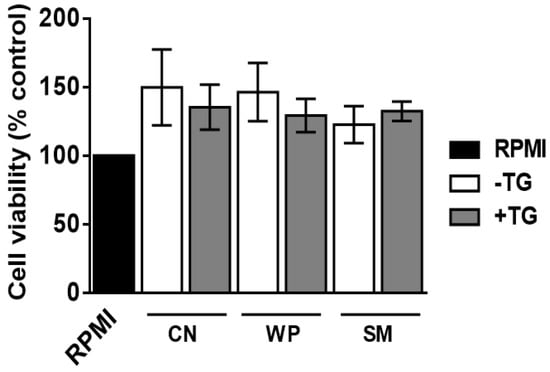
Figure 5.
Cytotoxicity assay. The MTT method was used to determine the viability of spleen cells from casein (CN), whey protein (WP), and skim milk (SM) sensitized BALB/c mice cultured with either untreated (white bars) or TG cross-linked CN, WP, and SM (grey bars).
3.4. Impact of Crosslinking on Digestibility of Milk Proteins
The resistance to in vitro gastric digestion of TG treated SM, CM, and WP was higher than that of the native proteins, and this was especially noticeable during the first minutes of pepsin treatment (Figure 6). Resistance to digestion could be used as a predictive factor in assessing the allergenic potential of a protein [35] and, in this respect, it is essential to evaluate the digestion process of proteins within the food matrix in which they are usually found [20]. As shown in Figure 6, digestion with pepsin did not lead to complete hydrolysis, as there was intact protein in all cases, while SM and CN were almost completely hydrolyzed with Corolase PP. In the case of WP, intact protein was still observed after 30 min of simulated duodenal digestion in both native and TG-treated proteins, although the peak corresponding to intact proteins was higher in the cross-linked sample.
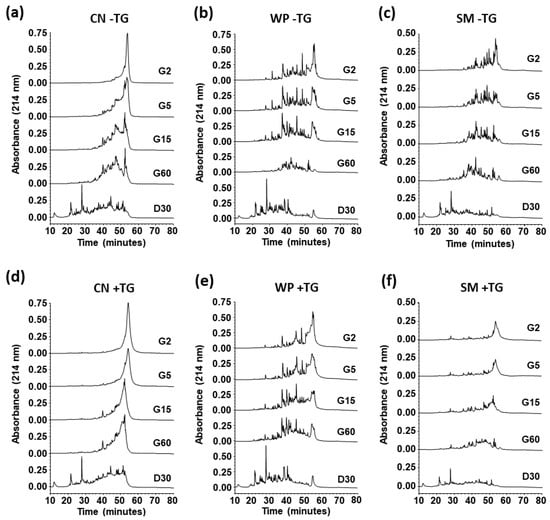
Figure 6.
Digestibility of TG cross-linked milk proteins. RP-HPLC patterns of untreated (−TG; a–c) and TG cross-linked (+TG; d–f) casein (CN; a,d), whey proteins (WP; b,e), and skim milk (SM; c,f), after 2 (G2), 5 (G5), 15 (G15), and 60 (G60) min of simulated gastric digestion with pepsin, and subsequent duodenal digestion with Corolase PP for 30 min (D30).
The peptide profile generated during digestion in the gastric and duodenal phases was similar in the native samples and in those treated with TG. Similar results were found by Fotschki et al., who observed that TG influenced the gastric digestibility of cow and horse milk, slowing digestion of the proteins [20]. Cross-linked β-LG was found to be more resistant to simulated gastrointestinal digestion [10]. In contrast, polymerization of chemically denatured β-LG with TG was reported to facilitate the action of gastrointestinal enzymes [32]. Similarly, Havenaar et al. [36] indicated that caseinate treated with TG was more digestible than the untreated protein. These discrepancies may be due to the use of different polymerization conditions and in vitro digestion protocols, as it is well known that the rate of digestion of polymerized proteins depends on the type of structure generated [37].
As expected, in vitro gastrointestinal digestion significantly reduced the IgE-binding capacity of SM, CN, and WP (Table 2). The concentration (μg/mL) for 50% of the maximal IgE binding, also known as EC50, of SM and CN treated with TG after gastric and duodenal digestion was approximately an order of magnitude higher than that of the digests for the native samples and similar results were obtained for WP samples. These data are in agreement with the lower digestibility of samples cross-linked with TG observed by RP-HPLC (Figure 6).

Table 2.
IgE binding to untreated and TG cross-linked slim milk (SM), casein (CN), and whey proteins (WP), before and after gastric and duodenal digestion, as estimated by inhibition ELISA with sera from milk allergic patients (EC50, µg/mL).
4. Conclusions
TG was effective in crosslinking SM, CN, and WP, forming high molecular weight polymers, although a substantial amount of unmodified monomeric serum proteins remained. Although the binding of human IgE to β-CN was significantly reduced and that to β-LG and α-LA was increased after treatment of SM, CN, and WP with TG, no differences were observed in either case in the ability to induce mast cell degranulation compared to the untreated proteins. SM and CN subjected to cross-linking induced a lower release of Th2 cytokines from splenocytes of mice sensitized, respectively, to SM and CN, but WP treated with TG did not modify the production of IL-4 and IL-13 with respect to the native protein in spleen cells from WP-sensitized mice. TG-treated SM, CM, and WP were more resistant to digestion than the untreated proteins and, consequently, the binding of human IgE to their digests was also higher. These results question the use of crosslinking with transglutaminase to obtain hypoallergenic products.
Author Contributions
Conceptualization: S.B. and E.M.; methodology: M.M.-B. and S.B.; validation: S.B. and R.L.-F.; formal analysis: S.B.; investigation: M.M.-B., S.B., E.M. and R.L.-F.; resources: S.B., E.M. and R.L.-F.; data curation: S.B., E.M. and R.L.-F.; writing—original draft preparation: S.B. and E.M.; writing—review and editing, all authors.; visualization: E.M. and S.B.; supervision, all authors; project administration: E.M. and R.L.-F.; funding acquisition: E.M. and R.L.-F.; final approval of the version, all authors. All authors have read and agreed to the published version of the manuscript.
Funding
This work was supported by the Ministerio de Ciencia, Innovación y Universidades (project AGL2017-88964-R) and Ministerio de Ciencia e Innovación through a project (PID2021-123236OB-I00) and a Juan de la Cierva Incorporación contract (SB) (IJCI-2017-31345 B).
Institutional Review Board Statement
The study was conducted according to the guidelines of the Declaration of Helsinki, following the European legislation (Directive 2010/63/EU) and approved by the Institutional Review Board of Dirección General de Agricultura, Ganadería y Alimentación from Comunidad de Madrid (PROEX 286.8/20).
Informed Consent Statement
Not applicable.
Data Availability Statement
Not applicable.
Acknowledgments
CSIC Interdisciplinary Thematic Platform (PTI) Alergias alimentarias. (PTI-FOODALLERGY).
Conflicts of Interest
The authors declare no conflict of interest.
References
- Flom, J.D.; Sicherer, S.H. Epidemiology of cow’s milk allergy. Nutrients 2019, 11, 1051. [Google Scholar] [CrossRef]
- McGregor, R.; Poppitt, S.D. Milk proteins and human health. In Milk Proteins: From Expression to Food; Singh, H., Boland, M., Thompson, A., Eds.; Academic Press: London, UK; Waltham, MA, USA; San Diego, CA, USA, 2014; pp. 651–669. [Google Scholar]
- Vassilopoulou, E.; Christoforou, C.; Andreou, E.; Heraclides, A. Effects of food allergy on the dietary habits and intake of primary schools’ Cypriot children. Eur. Ann Allergy Clin. Immnunol. 2017, 49, 181–185. [Google Scholar] [CrossRef]
- Verhoeckx, K.C.M.; Vissers, Y.M.; Baumert, J.L.; Faludi, R.; Feys, M.; Flanagan, S.; Herouet-Guicheney, C.; Holzhauser, T.; Shimojo, R.; van der Bolt, N.; et al. Food processing and allergenicity. Food Chem. Toxicol. 2015, 80, 223–240. [Google Scholar] [CrossRef]
- Gharibzahedi, S.M.T.; Koubaa, M.; Barba, F.J.; Greiner, R.; George, S.; Roohinejad, S. Recent advances in the application of microbial transglutaminase crosslinking in cheese and ice cream products: A review. Int. J. Biol. Macromol. 2017, 107, 2364–2374. [Google Scholar] [CrossRef]
- Sabadin, I.S.; Villas-Boas, M.B.; de Lima Zollner, R.; Netto, F.M. Effect of combined treatment of hydrolysis and polymerization with transglutaminase on β-lactoglobulin antigenicity. Eur. Food Res. Technol. 2012, 235, 801–809. [Google Scholar] [CrossRef]
- Damodaran, S.; Li, Y. A two-step enzymatic modification method to reduce immuno-reactivity of milk proteins. Food Chem. 2017, 237, 724–732. [Google Scholar] [CrossRef]
- Olivier, C.E.; Lima, R.P.; Pinto, D.G.; Santos, R.A.; Silva, G.K.; Lorena, S.L.; Villas-Boas, M.B.; Netto, F.M.; de Lima Zollner, R. In search of a tolerance-induction strategy for cow’s milk allergies: Significant reduction of beta-lactoglobulin allergenicity via transglutaminase/cysteine polymerization. Clinics 2012, 67, 1171–1179. [Google Scholar] [CrossRef]
- Van Esch, B.C.; Gros-van Hest, M.; Westerbeek, H.; Garssen, J. Sensitizing capacity and allergenicity of enzymatically cross-linked sodium caseinate in comparison to sodium caseinate in a mouse model for CMA. Toxicol. Lett. 2013, 218, 50–55. [Google Scholar] [CrossRef] [PubMed]
- Stojadinovic, M.; Pieters, R.; Smit, J.; Cirkovic Velickovic, T. Cross-linking of β-lactoglobulin enhances allergic sensitization through changes in cellular uptake and processing. Toxicol. Sci. 2014, 140, 224–235. [Google Scholar] [CrossRef] [PubMed]
- Sosulski, F.W.; Imafidon, G.I. Amino-acid-composition and nitrogen-to-protein conversion factors for animal and plant foods. J. Agric. Food Chem. 1990, 38, 1351–1356. [Google Scholar] [CrossRef]
- Jiménez-Sáiz, R.; Martos, G.; Carrillo, W.; López-Fandiño, R.; Molina, E. Susceptibility of lysozyme to in-vitro digestion and immunoreactivity of its digests. Food Chem. 2011, 127, 1719–1726. [Google Scholar] [CrossRef]
- Benedé, S.; Cody, E.; Agashe, C.; Berin, M.C. Immune characterization of bone marrow-derived models of mucosal and connective tissue mast cells. Allergy Asthma Clin. Immnunol. Res. 2018, 10, 268–277. [Google Scholar] [CrossRef] [PubMed]
- Pablos-Tanarro, A.; Lopez-Expósito, I.; Lozano-Ojalvo, D.; López-Fandiño, R.; Molina, E. Antibody production, anaphylactic signs, and T-cell responses induced by oral sensitization with ovalbumin in BALB/c and C3H/HeOuJ mice. Allergy Asthma Immnunol. Res. 2015, 8, 239–245. [Google Scholar] [CrossRef] [PubMed]
- Benedé, S.; Berin, M.C. Mast cell heterogeneity underlies different manifestations of food allergy in mice. PLoS ONE 2018, 13, e0190453. [Google Scholar] [CrossRef] [PubMed]
- Benedé, S.; Lopez-Exposito, I.; Gimenez, G.; Grishina, G.; Bardina, L.; Sampson, H.A.; Lopez-Fandiño, R.; Molina, E. Mapping of IgE epitopes in in vitro gastroduodenal digests of beta-lactoglobulin produced with human and simulated fluids. Food Res. Int. 2014, 62, 1127–1133. [Google Scholar] [CrossRef]
- Özrenk, E. The use of transglutaminase in dairy products. Int. J. Dairy Technol. 2006, 59, 1–7. [Google Scholar] [CrossRef]
- Hsieh, J.F.; Pan, P.H. Proteomic profiling of microbial transglutaminase-induced polymerization of milk proteins. J. Dairy Sci. 2012, 95, 580–589. [Google Scholar] [CrossRef]
- Villas-Boas, M.B.; Vieira, K.P.; Trevizan, G.; Zollner, R.D.; Netto, F.M. The effect of transglutaminase-induced polymerization in the presence of cysteine on b-lactoglobulin antigenicity. Int. Dairy J. 2010, 20, 386–392. [Google Scholar] [CrossRef]
- Fotschki, J.; Wróblewska, B.; Fotschki, B.; Kalicki, B.; Rigby, N.; Mackie, A. Microbial transglutaminase alters the immunogenic potential and cross-reactivity of horse and cow milk proteins. J. Dairy Sci. 2019, 103, 2153–2166. [Google Scholar] [CrossRef]
- Duarte, N.M.; Cruz, A.L.; Silva, D.C.; Cruz, G.M. Intake of whey isolate supplement and muscle mass gains in young healthy adults when combined with resistance training: A blinded randomized clinical trial (pilot study). J. Sport. Med. Phys. Fit. 2020, 60, 75–84. [Google Scholar] [CrossRef]
- Ma, X.; Lozano-Ojalvo, D.; Chen, H.; Lopez-Fandiño, R.; Molina, E. Effect of high pressure-assisted crosslinking of ovalbumin and egg white by transglutaminase on their potential allergenicity. Innov. Food Sci. Emerg. Technol. 2015, 29, 143–150. [Google Scholar] [CrossRef]
- Tian, Y.; Liu, C.; Xue, W.; Wang, Z. Crosslinked recombinant-Ara h 1 catalyzed by microbial transglutaminase: Preparation, structural characterization and allergic assessment. Foods 2020, 9, 1508. [Google Scholar] [CrossRef] [PubMed]
- Fu, L.; Ni, S.; Wang, C.; Wang, Y. Transglutaminase-catalysed cross-linking eliminates Penaeus chinensis tropomyosin allergenicity by altering protein structure. Food Agric. Immnunol. 2019, 30, 296–308. [Google Scholar] [CrossRef]
- Leszczyńska, J.; Łącka, A.; Bryszewska, M. The use of transglutaminase in the reduction of immunoreactivity of wheat flour. Food Agric. Immnunol. 2006, 17, 105–113. [Google Scholar] [CrossRef]
- Meng, S.; Tan, Y.; Chang, S.; Li, J.; Maleki, S.; Puppala, N. Peanut allergen reduction and functional property improvement by means of enzymatic hydrolysis and transglutaminase crosslinking. Food Chem. 2020, 302, 125186. [Google Scholar] [CrossRef]
- Palosuo, K.; Varjonen, E.; Nurkkala, J.; Kalkkinen, N.; Harvima, R.; Reunala, T.; Alenius, H. Transglutaminase-mediated cross-linking of a peptic fraction of ω-5 gliadin enhances IgE reactivity in wheatdependent, exercise-induced anaphylaxis. J. Allergy Clin. Immnunol. 2003, 111, 1386–1392. [Google Scholar] [CrossRef]
- Nakamura, R.; Nakamura, R.; Sakai, S.; Urisu, A.; Fukutomi, Y.; Teshima, R. Tissue transglutaminase generates deamidated epitopes on gluten, increasing reactivity with hydrolyzed wheat protein-sensitized IgE. J. Allergy Clin. Immnunol. 2013, 132, 1436–1438. [Google Scholar] [CrossRef]
- Benedé, S.; Blázquez, A.B.; Chiang, D.; Tordesillas, L.; Berin, M.C. The rise of food allergy: Environmental factors and emerging treatments. EBioMedicine 2016, 7, 27–34. [Google Scholar] [CrossRef]
- Stanic, D.; Monogioudi, E.; Ercili, D.; Radosavljevic, J.; Atanaskovic-Markovic, M.; Vuckovic, O.; Raija, L.; Mattinen, M.; Buchert, J.; Cirkovic Velickovic, T. Digestibility and allergenicity assessment of enzymatically crosslinked β-casein. Mol. Nutr. Food Res. 2010, 54, 1273–1284. [Google Scholar] [CrossRef]
- Olivier, C.E.; Villas-Boas, M.B.; Netto, F.M.; Zollner, R.D.L. Allergenicity of Bos d 5 in children with cow’s milk allergyis reduced by transglutaminase polymerization. Pediatr. Allergy Immunol. Pulmonol. 2012, 25, 30–33. [Google Scholar] [CrossRef]
- Villas-Boas, M.B.; Benedé, S.; Zollner, R.D.; Netto, F.M.; Molina, E. Epitope resistance to the simulated gastrointestinal digestion of beta-lactoglobulin submitted to two-step enzymatic modification. Food Res. Int. 2015, 72, 191–197. [Google Scholar] [CrossRef]
- Bai, J.; Hui, J.; Lu, Q.; Yang, A.; Yuan, J.; Gao, J.; Wu, Z.; Li, X.; Tong, P.; Chen, H. Effect of transglutaminase cross-linking on the allergenicity of tofu based on a BALB/c mouse model. Food Func. 2020, 11, 404–413. [Google Scholar] [CrossRef] [PubMed]
- De Souza, C.F.V.; Venzke, J.G.; Rosa, R.M.; Henriques, J.A.P.; Dallegrave, E.; Flôres, S.H.; Ayub, M.A.Z. Toxicological evaluation for food applications of transglutaminase from a newly isolated Bacillus circulans BL32. Am. J. Food Technol. 2011, 6, 460–471. [Google Scholar] [CrossRef]
- Verhoeckx, K.; Bøgh, K.L.; Dupont, D.; Egger, L.; Gadermaier, G.; Larré, C.; Mackie, A.; Menard, O.; Adel-Patient, K.; Picariello, G.; et al. The relevance of a digestibility evaluation in the allergenicity risk assessment of novel proteins. Opinion of a joint initiative of COST action ImpARAS and COST action INFOGEST. Food Chem. Toxicol. 2019, 129, 405–423. [Google Scholar] [CrossRef]
- Havenaar, R.; de Jong, A.; Koenen, M.E.; van Bilsen, J.; Janssen, A.M.; Labij, E.; Westerbeek, H.J. Digestibility of transglutaminase cross-linked caseinate versus native caseinate in an in vitro multicompartmental model simulating young child and adult gastrointestinal conditions. J. Agric. Food Chem. 2013, 61, 7636–7644. [Google Scholar] [CrossRef]
- Macierzanka, A.; Böttger, F.; Lansonneur, L.; Groizard, R.; Jean, A.S.; Rigby, N.M.; Cross, K.; Wellner, N.; Mackie, A.R. The effect of gel structure on the kinetics of simulated gastrointestinal digestion of bovine β-lg. Food Chem. 2012, 134, 2156–2163. [Google Scholar] [CrossRef]
Publisher’s Note: MDPI stays neutral with regard to jurisdictional claims in published maps and institutional affiliations. |
© 2022 by the authors. Licensee MDPI, Basel, Switzerland. This article is an open access article distributed under the terms and conditions of the Creative Commons Attribution (CC BY) license (https://creativecommons.org/licenses/by/4.0/).